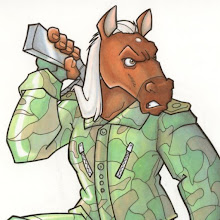About a month ago, a Palladium forum member (Dolcet) who was looking for ideas for 'a race calling itself the Beholders. These Beholders consider themselves to be the Paragons of existence; for only they can truly know what beauty is and all other living things must die for the crime of not being a Beholder.' [link]
I thought about this for a while, but initially dismissed it because I thought it too two-dimensional of an enemy. Like the Daleks, Cybermen, and Borg, there really isn't much to them beyond kill anything that isn't you. This would make sense if you were working with a hivemind species, but I felt that's been done to death (Aliens, Borg, Mimic, etc). I then thought about the Beholders being more of a group or society of zealots instead of an elitist race. Then I realized how this could reflect that elitist hate that humanity is famous for (be it race, religion, nationality, or gender). This, I started to think, was starting to sound more and more interesting.
The question then became, how are these "Beholders" conducting their genocidal campaign? I was stuck on this. Why would The Beholders, a group that epitomized beauty, have access to weapons of war? What weapons would they use? As I mulled this, I started thinking back to a scene from the old 1950's War of the Worlds movies, three large war machines protected by impenetrable shields, slowly advancing across the countryside, killing all in their path. It was a start. Then came memories of old horror movies like the House of Wax and the Medusa Transducer from the Rocky Horror Picture Show.
That was it! I'd change the heat rays to Medusa Rays! Everyone struck by these beams would be turned into calcified (stone) statues. The Beholder's madness would see this as poetic justice, turning these pitiful creatures that cannot possibly understand or appreciate "true" beauty into works of art, and then leaving these statues scattered across the landscape for posterity. Death by Art.
Then, today, I finally brought it all together:
The Beholders are a group of bioengineered humans (artists, curators, aficionados and the like) from before the Big Death. They had engineered themselves with better senses and other talents so that they could create and/or appreciate art and beauty to the ultimate extent. After the Big Death, these Beholders cloistered themselves away from the ravaged world for decades in an old art museum. After all the decades secluded away from the outside world and surrounded by the beauty of the artwork they adored and protected, they fell into madness. They never once considered leaving their museum, as nothing outside its walls could compare to the beauty that they guarded within.
As time passed, a few of these Beholders wanted to join the museums collection, and in a bid to preserve their own perfection, developed a method of rapid calcification of the body, figuratively turning them to stone. Over the years, a handful of the older or more vain Beholders submitted themselves to this procedure, helping perfect it.
Then one day the museum was discovered by a band of scavengers looking for valuables from the old world to sell. The scavengers were quickly caught by the museums Guargoyles, and when the scavengers were interrogated the Beholders were horrified that these scavengers saw their artwork only as items to sell for profit, not appreciated and fawned over. This revelation angered them to the point where they began their genocidal campaign against anyone that couldn't be identified as a Beholder.
The few mechanically minded among them built a number of majestic war machines, works of art that they would march out and across the land and do away with those who could not appreciate beauty like the Beholders could. These war machines stood a hundred feet tall so that they could be seen and appreciated by all around it. They were armed with calcification rays so that these blind ignoramuses could be turned into works of art to beautify the world. And finally, they were protected by force fields that the museum had used to protect some of the larger displays.
On their first battle, if you could call it that, three of the Beholders machines came silently upon an encampment of Free Cattle late on the night of a new moon. When dawn broke, the Beholders watched as the people came out to gaze upon these tall wonders that had appeared around them. At first they Beholders thought that these people may be redeemable, but that one of them picked up a rock and threw it at one of the machines. Immediately, the Beholders opened fire upon the Free Cattle and turned them all to stone before marching on in search of others.
The hook for the adventure would be that one of the scavengers was able to elude capture and then escaped the museum after the Beholders "killed" the rest of the scavengers and left on their genocidal rampage. The group could be brought into the story in a number of ways, here are some examples:
- After finding a village populated only by these odd statues, they encounter the escaped scavenger who relates his mad tale.
- Cardanian scouts capture and interrogated the escaped scavenger, and the group is assigned to validate his mad claims.
- A wealthy individual hires the group to discover what happened to the scavengers he hired to loot an old museum hidden in the ruins of a distant city. They then encounter the surviving scavenger and a few Beholders who have stayed behind to guard the museum.
I will work on and post some stats for the Beholders, their War Machines, and the Museum soon.



